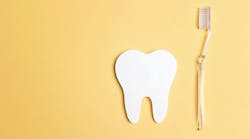Poor oral health and oral dysbiosis: A link to systemic diseases and cancer
The oral cavity is home to more than 700 types of bacteria. While some bacterial species are beneficial for dental and overall health, others can play a role in the development of serious systemic illnesses.
Studies show that maintaining a balanced microbial ecosystem in the mouth is crucial for oral health and has a significant impact on how the body responds to various diseases. Dysbiosis, an imbalanced oral microbiome or ecosystem, can lead to various health issues ranging from common dental problems such as cavities and gum disease to severe conditions such as heart disease, Alzheimer’s disease, and diabetes.1,2
More about oral-systemic health … Oral-systemic health: Effects on athletic performance
Recent studies have revealed that oral dysbiosis may even be involved in the development of life-threatening digestive cancers. Digestive cancers include cancers located in the esophagus, stomach, liver, pancreas, colon, and rectum. Their incidence and related mortality are increasing worldwide, with most new cases of digestive cancers (63%) and related deaths (65%) occurring in Asia, followed by Europe and North America.3
Scientists believe that many forms of digestive cancer are influenced by various environmental factors that can potentially be changed. These include tobacco smoking, diet, alcohol consumption, and obesity. Some recent evidence also suggests a role of the human oral microbiota in the development of digestive cancers. Fusobacterium nucleatum (F. nucleatum) is one bacterial species commonly found in the mouth and is a key member of colorectal cancer-associated bacteria. Many other oral pathogens can play a role in the development of cancer as well.4,5
More about oral-systemic health … Oral-systemic health link: Tips for a healthy body and a happy smile
Exposing the oral bacteria-pancreatic cancer link
One study published in the British Journal of Cancer (BJC) reported that Trepenoma denticola (T. denticola), the bacteria responsible for periodontitis, may cause pancreatic cancer.6,7 Pancreatic cancer is one of the deadliest forms of cancer caused by the abnormal and uncontrolled growth of cells in the pancreas, a large gland that is part of the digestive system. About half of all new cases are diagnosed in people aged 75 or over.8
T. denticola can enter the bloodstream through inflamed gums and spread to other parts of the body. If left untreated and undiagnosed, periodontal disease contributes to the development and spread of cancer and cancer deaths—not only from oral cancer but especially pancreatic cancer, explains Timo Sorsa, DDS, PhD, professor of oral and maxillofacial diseases at the University of Helsinki, Finland.
Dr. Sorsa points out that the Treponema bacterium shares a specific enzyme with some cancer types in the gut. This enzyme is called Treponema denticola chymotrypsin-like proteinase (or dentilisin) and is usually found in the mouth where it is known to contribute to severe periodontitis. This same enzyme has also been observed in malignant and life-threatening tumors.6,7
In the oral cavity, dentilisin not only contributes to gum disease but also triggers other enzymes that promote cancer. These enzymes are called matrix metalloproteinases (MMPs), and they break down the material between cells and cell membranes, making it easier for cancer to invade healthy tissue. This connection raises concerns about potential health issues related to dentilisin in the oral cavity, as Dr. Sorsa stresses.
The BJC study from 2017 was the first to show that virulence factors from the bacteria that cause gum disease could spread from the mouth to other parts of the body and take part in central mechanisms of cancer-related tissue destruction.
Since then, supplementary research has supported the study’s findings. One report released in the International Journal of Cancer by Sorsa et al. examined registry data for more than 10 years on more than 68,000 adults in Finland who had made a primary dental health-care visit. The study revealed that periodontitis was associated with a 33% increased risk for overall cancer mortality. The mortality risk associated with gum disease among individuals with pancreatic cancer was far higher, with a more than twofold increased risk.7
From fast diagnosis to quick onset of treatment
The links revealed so far between oral bacteria and cancer developments have inspired Dr. Sorsa’s team to search for ways to help prevent cancerous developments. One potential solution is to detect gum infections in their initial stages through early diagnosis. By quickly identifying gum disease with a chairside aMMP-8 rapid test, researchers believe that certain cancers could be prevented as the test allows faster treatment of the underlying issue: gum inflammation. As Dr. Sorsa says, the test makes the invisible visible.9,10 Out of all MMP enzymes, the active MMP-8 enzyme has been found to be elevated in patients suffering from gum disease leading to periodontal connective tissue destruction.
Periodontitis, or severe gingivitis, is estimated to affect as much as half of the global population, often without showing any symptoms. Early detection of these diseases is important to allow for intervention and treatment before irreversible damage occurs. Traditional methods such as checkups and x-rays might, however, miss early signs of these diseases since they often become symptomatic in later stages.
By using biomarkers such as aMMP-8, clinicians can spot subtle inflammation and tissue damage, allowing them to start treatment before the disease becomes visible.
The aMMP-8 rapid test can noninvasively measure and assess active periodontal adhesive tissue loss and the risk of its progression within five minutes in the dental chair. The test complements the diagnosis, follow-up, and maintenance treatment of periodontitis and peri-implantitis, explains Dr. Sorsa.11
More about oral-systemic health … How antibacterial photodynamic therapy improves oral health in patients with Sjögren’s syndrome
Advanced approaches for treating oral diseases
Periodontal and peri-implant diseases are conditions that affect the supporting structures of teeth and dental implants, and they can lead to tooth loss if left untreated. Gum infections can develop for various reasons. One key factor is the build-up of bacterial plaque (biofilm) on the surfaces of teeth due to inadequate oral hygiene.9
While tooth decay is the most common disease in the world, and inflammation of the supporting tissues of the teeth is the sixth most common disease worldwide, the medical community struggles to find new solutions to combat these infections. Dr. Sorsa notes that dental plaque bacteria are responsible for a staggering 95% of oral ailments. He also highlights the significance of modern antibacterial methods in promoting good oral hygiene and effective plaque removal. Research shows antibacterial photodynamic therapy (aPDT) to be a promising approach to treat bacterial infections, even ones that don’t respond well to antibiotics.12
Until recently, aPDT treatment for improving oral health was solely available at dental clinics, frequently at a substantial cost. Dr. Sorsa highlights the work of Finnish scientists who have pioneered an at-home oral health-enhancing device based on aPDT, which provides a drug-free alternative for the management and prevention of oral and gum diseases.
Poor oral health is linked to more than 200 chronic diseases, stresses Tommi Pätilä, MD, PhD, a researcher and cardiac and organ transplant surgeon at the New Children’s Hospital in Helsinki, Finland’s largest hospital focusing on demanding specialist pediatric medical care.
aPDT technology enhances oral hygiene when it is administered regularly in addition to brushing and flossing, and research shows it can also enhance the effectiveness of professional dental care. It may even reduce the need for conventional medications such as antibiotics and chlorhexidine in the treatment of oral and gum diseases. Based on a light-activated antibacterial effect, the patented home-use device slows down plaque formation and significantly reduces the burden of harmful bacteria in the mouth. aPDT treatment administered regularly at home is suitable for patients of all ages, but it is particularly recommended for those with a history of problems caused by common oral diseases, tooth decay, and gum disease.9
The crucial role of oral hygiene in cancer care
Brushing and flossing regularly to remove dental plaque from the surfaces of teeth and interdental spaces are keys to maintaining a healthy mouth. But that’s not always enough. Good oral hygiene requires adequate motor and mental skills. Studies show that even the most effective electric toothbrush removes only about 65% of harmful oral bacteria from the mouth.13
The key to overall well-being is good oral hygiene. For cancer patients, this is even more important because they must maintain a high-calorie diet to fight the disease, notes Tuomas Waltimo, DDS, PhD, from the University of Basel. Dr. Waltimo also serves as a private dentist at a clinic that offers dental services to patients with special dental needs, including patients undergoing cancer treatments. He emphasizes that cancer treatments often bring along side effects that can require special attention. Mucositis, for example, can lead to generalized infection and even be life-threatening.
Mucositis is the painful inflammation and ulceration of the mucous membranes lining the digestive tract. It can occur anywhere along the gastrointestinal tract, but oral mucositis refers to the inflammation and ulceration that occurs specifically in the mouth. Maintaining good oral hygiene habits is a prerequisite for treating oral mucositis.
“Good oral hygiene is also of paramount importance in the management of oral mucositis. Initial findings suggest a light-activated antibacterial treatment (Lumoral) may help prevent and potentially treat oral mucositis, but this hypothesis requires further scientific research to confirm. We are, therefore, starting a new PhD study to examine the topic at the University of Helsinki,” says Dr. Waltimo.
Editor’s note: This article first appeared in Through the Loupes newsletter, a publication of the Endeavor Business Media Dental Group. Read more articles and subscribe to Through the Loupes.
References
- Maier T. Oral microbiome in health and disease: maintaining a healthy, balanced ecosystem and reversing dysbiosis. Microorganisms. 2023;11(6):1453. doi:10.3390/microorganisms11061453
- de Araújo Silva DN, Casarin M, Monajemzadeh S,de Brito BezerraB, Lux R,Pirih FQ. The microbiome in periodontitis and diabetes. Front Oral Health. 2022;3:859209. doi:10.3389/froh.2022.85920
- Gastrointestinal cancers global burden expected to rise. National Cancer Institute. Division of Cancer Epidemiology & Genetics. April 10, 2020. https://dceg.cancer.gov/news-events/news/2020/global-burden-gastro
- Pignatelli P, Nuccio F, Piattelli A, Curia MC. The role of Fusobacterium nucleatum in oral and colorectal carcinogenesis. Microorganisms. 2023;11(9):2358. doi:10.3390/microorganisms11092358
- Reitano E, de’Angelis N, Gavriilidis P, et al. Oral bacterial microbiota in digestive cancer patients: a systematic review. Microorganisms. 2021;9(12):2585. doi:10.3390/microorganisms9122585
- Nieminen M, Listyarifah D, Hagström J. et al. Treponema denticola chymotrypsin-like proteinase may contribute to orodigestive carcinogenesis through immunomodulation. Br J Cancer. 2018;118(3):428-434. doi:10.1038/bjc.2017.409
- Heikkilä P, But A, Sorsa T, Haukka J. Periodontitis and cancer mortality: register-based cohort study of 68,273 adults in 10-year follow-up. Int J Cancer. 2018;142(11):2244-2253. doi:10.1002/ijc.31254
- Pancreatic cancer. NHS Inform. Updated November 14, 2023. https://www.nhsinform.scot/illnesses-and-conditions/cancer/cancer-types-in-adults/pancreatic-cancer/
- Pakarinen S, Saarela RKT, Välimaa H, et al. Home-applied dual-light photodynamic therapy in the treatment of stable chronic periodontitis (HOPE-CP)—three-month interim results. Dent J (Basel). 2022;10(11):206. doi:10.3390/dj10110206
- Sorsa T, Gursoy UK, Nwhator S, et al. Analysis of matrix metalloproteinases, especially MMP-8, in gingival creviclular fluid, mouthrinse and saliva for monitoring periodontal diseases. Periodontol 2000. 2016;70(1):142-163. doi:10.1111/prd.12101
- Sorsa T, Nwhator SO, Sakellari D, et al. aMMP-8 oral fluid PoC test in relation to oral and systemic diseases. Front Oral Health. 2022;3:897115. doi:10.3389/froh.2022.897115
- Liu Y, Qin R, Zaat SAJ, Breukink E, Heger M. Antibacterial photodynamic therapy: overview of a promising approach to fight antibiotic-resistant bacterial infections. J Clin Transl Res. 2015;1(3):140-167.
- Aggarwal N, Gupta S, Grover R, Sadana G, Bansal K. Plaque removal efficacy of different toothbrushes: a comparative study. Int J Clin Pediatr Dent. 2019;12(5): 385-390. doi:10.5005/jp-journals-10005-1669
Nina Garlo-Melkas, MSc, is a health and science journalist who works as communications manager at Koite Health Ltd., a quickly growing health technology company and innovator in light-activated antibacterial solutions for treating and preventing oral diseases.







